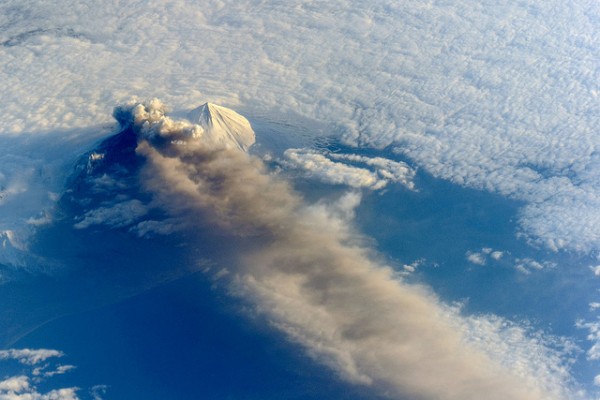By Ana Verayo, | March 28, 2016

Astronauts aboard the International Space Station (ISS) photographed these striking views of Pavlof Volcano on May 18, 2013.
On Sunday, a volcano eruption in southwestern Alaska sent an ash cloud up to a towering 30,000 feet into the atmosphere. The Pavlof volcano erupted near the southern tip of the Alaskan Peninsula that suddenly expelled black ash and ribbons of lava around 4 P.M. local time.
This explosive eruption does not pose any threat to Unalaska local residents says geologist Michelle Coombs of the United States Geological Survey, adding that this eruption did not generate any earthquake or tsunami threat.
Like Us on Facebook
According to Coombs who is currently at the Alaska Volcano Observatory in Anchorage, the eruption was noticed shortly after four in the afternoon where it was seen on the seismicity. After this, pilot reports began to come in saying that a black ash cloud was observed above the volcano where it continues to erupt until now.
The Observatory considers Pavlof as one of the most active volcanoes along the Aleutian Range, with more than 40 eruptions in recent history. Its last eruption was recorded in 2014 where this volcano is known for having eruptions that can last from a few days to as long as a few months.
This type of volcanic activity has been considered as fairly common for Pavlof, however, geologists say that this eruption was a surprise.
Coombs revealed that Pavlof is an open system volcano which means eruptions will not have yielded any prior warnings. The magma in this type of volcano can break through the surface fairly easily which can sneak upon us, she adds. This is also the reason why there is no warning prior to Sunday afternoon's eruption.
Those who are living in the Aleutian mountains can only feel the effects of this eruption with possible flight diversions and cancellations. The Observatory already issued a Sigmet (Significant Meteorological Information) advisory for the surrounding region of the volcano that alerts pilots about this growing ash cloud that is moving up north.
The nearest human community in the area is Cold Bay which is 37 miles northeast from Pavlof volcano, in a remote and mostly uninhabited area of the Peninsula. Coombs adds that communities like Nelson's Lagoon and Sand Point may get small amounts of ash fall depending on the direction the wind is blowing, but there will be definitely no ash fall in Unalaska.
-
Use of Coronavirus Pandemic Drones Raises Privacy Concerns: Drones Spread Fear, Local Officials Say

-
Coronavirus Hampers The Delivery Of Lockheed Martin F-35 Stealth Fighters For 2020

-
Instagram Speeds Up Plans to Add Account Memorialization Feature Due to COVID-19 Deaths

-
NASA: Perseverance Plans to Bring 'Mars Rock' to Earth in 2031

-
600 Dead And 3,000 In The Hospital as Iranians Believed Drinking High-Concentrations of Alcohol Can Cure The Coronavirus

-
600 Dead And 3,000 In The Hospital as Iranians Believed Drinking High-Concentrations of Alcohol Can Cure The Coronavirus

-
COVID-19: Doctors, Nurses Use Virtual Reality to Learn New Skills in Treating Coronavirus Patients







